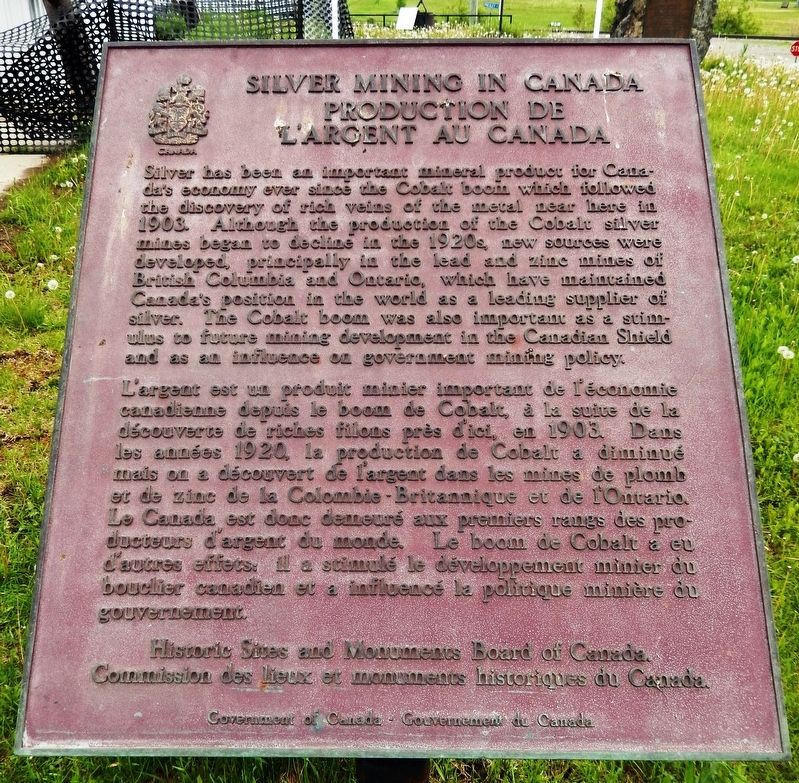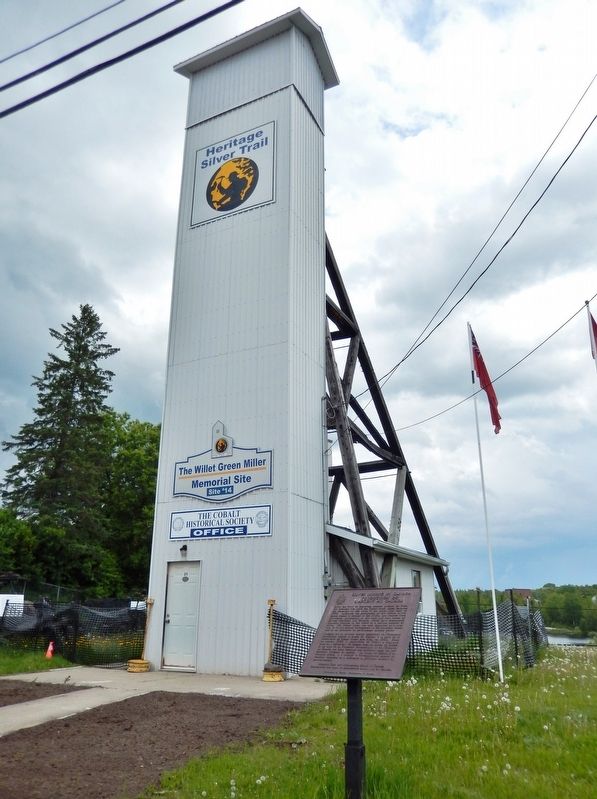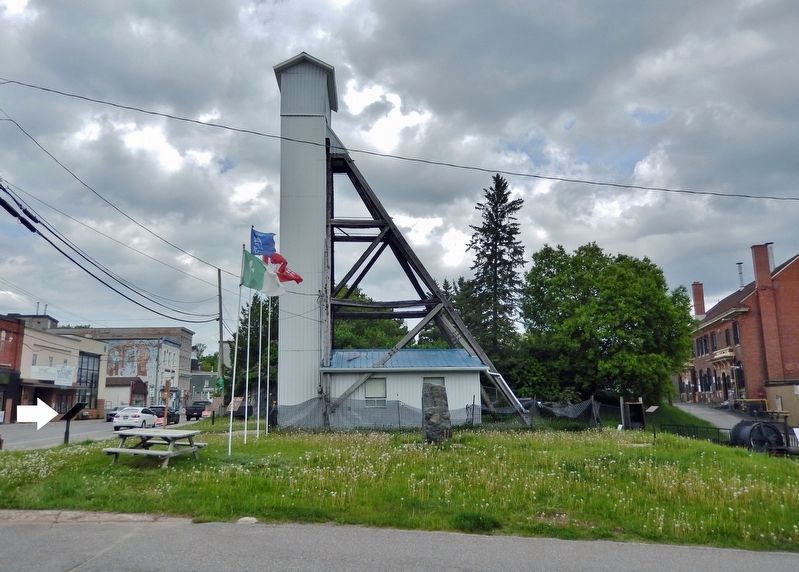Cobalt in Timiskaming District, Ontario — Central Canada (North America)
Silver Mining in Canada / Production de L'argent au Canada
Inscription.
[English]
Silver has been an important mineral product for Canada’s economy ever since the Cobalt boom which followed the discovery of rich veins of the metal near here in 1903. Although the production of the Cobalt silver mines began to decline in the 1920s, new sources were developed, principally in the lead and zinc mines of British Columbia and Ontario, which have maintained Canada’s position in the world as a leading supplier of silver. The Cobalt boom was also important as a stimulus to future mining development in the Canadian Shield and as an influence on government mining policy.
L'argent est un produit minier important de l'économie canadienne depuis le boom de Cobalt, à la suite de la découverte de richesses filons près d'ici, en 1903. Dans les années 1920, la production de Cobalt a diminué mais sur a à découvert de l'argent dans les mines de plomb et de zinc de la Colombie-Britannique et de l'Ontario. Le Canada est donc démuré aux premiers rangs des producteurs d'argent du monde. Le boom de Cobalt a eu d'autres effets : il a stimulé le développement minier du bouclier canadien et a influencé la politique minière du gouvernement.
Erected by Historic Sites and Monuments Board of Canada/Commission des lieux et monuments historiques du Canada.
Topics and series. This historical marker is listed in this topic list: Industry & Commerce. In addition, it is included in the Canada, Historic Sites and Monuments Board series list. A significant historical year for this entry is 1903.
Location. 47° 23.725′ N, 79° 41.136′ W. Marker is in Cobalt, Ontario, in Timiskaming District. Marker is on Silver Street just north of Bunker Lane, on the right when traveling north. Marker is located in front of the Pan Silver Headframe and directly across the street from the Cobalt Mining Museum. Touch for map. Marker is at or near this postal address: 21 Silver Street, Cobalt ON P0J 1C0, Canada. Touch for directions.
Other nearby markers. At least 8 other markers are within walking distance of this marker. Cobalt Mining Camp (here, next to this marker); City of Cobalt Shaft / Le puits de mine de la Ville de Cobalt (here, next to this marker); Willet Green Miller (a few steps from this marker); Bar and Arm Drill (a few steps from this marker); Cobalt Mining / L’exploitation Minière de Cobalt (a few steps from this marker); Centennial Time Capsule (a few steps from this marker); Mucking Machine or Overshot Loader
(a few steps from this marker); Side Dump Cars (a few steps from this marker). Touch for a list and map of all markers in Cobalt.
Also see . . .
1. Cobalt Silver Rush.
The Cobalt silver rush started in 1903 when huge veins of silver were discovered by workers on the Temiskaming and Northern Ontario Railway (T&NO) near the Mile 103 post. By 1905 a full-scale silver rush was underway, and the town of Cobalt, Ontario sprang up to serve as its hub. By 1908 Cobalt produced 9% of the world's silver, and in 1911 produced 31,507,791 ounces of silver. However, the good ore ran out fairly rapidly, and most of the mines were closed by the 1930s. The Cobalt Rush was instrumental in opening northern Ontario for mineral exploration.(Submitted on October 21, 2022, by Cosmos Mariner of Cape Canaveral, Florida.)
2. Cobalt’s silver boom and the rise of mining media in Canada.
The early history of hard rock mining in Ontario is essentially the story of the discovery of silver in Cobalt in 1903. It wasn’t long before the Cobalt mines became the third-largest producer of silver in the world and by the time the boom petered out in the 1920s, the camp had become the fourth-largest silver producer ever discovered. Today, most Canadians know about the Klondike gold rush in the Yukon, but few realize that the stampede for silver in Cobalt only five years later far surpassed the Klondike in terms of profits, production, and long-term impact. For the next half century, nearly every major discovery in Canada — from Noranda to Eldorado to Elliott Lake — was due to the skills and financial resources acquired at Cobalt.(Submitted on October 21, 2022, by Cosmos Mariner of Cape Canaveral, Florida.)
Credits. This page was last revised on October 21, 2022. It was originally submitted on October 21, 2022, by Cosmos Mariner of Cape Canaveral, Florida. This page has been viewed 55 times since then and 11 times this year. Photos: 1, 2, 3. submitted on October 21, 2022, by Cosmos Mariner of Cape Canaveral, Florida.


